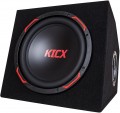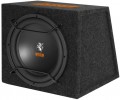Enclosure type
—
Closed box. The simplest type of case: a box closed on all sides with a speaker (speakers) on the front panel. The advantages of such models are high accuracy of sound transmission and low cost, the disadvantages are low sensitivity and somewhat “flat” bass.
—
Phase inverter. A classic phase inverter is a hollow tube connecting the internal volume of the case with the outside world (however, there are other options for such a connection). The length of the phase inverter channel is chosen so that the sound waves of a certain range, passing through it, are inverted in phase relative to the waves from the speaker (hence the name). This improves (in particular, "deepens") the sound of the subwoofer and allows you to achieve good performance with a small cabinet size. On the other hand, the sound stream in the tube creates a certain additional noise.
—
Strip. A design that combines the features of a closed box and a bass-reflex enclosure. One of its parts is made closed, and the second is equipped with a phase inverter tube; between them is a partition, on which the main speaker is located. Unlike previous types, the speaker is entirely inside the case. Strip-line enclosures provide louder sound than boxes or bass reflexes, with sound quality comparable to the latter. The disadvantage is the complexity of the design, as a result — a slightly higher price.
Rated power
The average (root mean square — RMS) power of the input signal, at which the subwoofer is able to work continuously without negative consequences (damage, failure) for at least an hour. The rated power of the subwoofer must be greater than the power of the amplifier connected to it — in order to avoid overloads.
Max. power
The maximum signal power that the subwoofer is able to withstand for a short time (up to several seconds) without any negative consequences. When selecting an amplifier-subwoofer pair, it is recommended to take a subwoofer with a maximum power of at least twice the maximum power of the amplifier. In general, the higher the maximum power, the more resistant the subwoofer is to overloads.
Frequency range
The range of audio frequencies reproduced by the subwoofer. It is believed that the human ear is capable of perceiving a frequency range of the order of 16 – 20,000 Hz, but in this case note that the subwoofer is designed to reproduce the lower frequency band (up to 200 Hz). Accordingly, in the case of the lower limit of the range, everything is simple: “the lower, the better”; the upper one should not be lower than the lower limit of the main car audio — otherwise there will be "gaps" in the frequencies, which will affect the sound quality.
Sensitivity
Sensitivity determines the loudness of the subwoofer when a signal of a certain power is connected to it: with equal signal power and impedance (see below), the subwoofer with the higher sensitivity will sound louder.
Phase control
The ability
to change the phase of the sound coming from the subwoofer, in other words, the ability to adjust the sound from the subwoofer to lead or lag relative to the main speakers. This need may be due to the fact that the sound from the main speakers and from the subwoofer can reach the listener with different delays — due to the location of the speakers and the features of the electronics — which negatively affects the sound quality. Adjusting the phases allows you to harmonize this sound. This feature is usually found in active subwoofers.
High voltage input
The presence of a
high-voltage input at the active (see "Type") subwoofer. Such an input greatly expands the possibilities for connection. Usually active subwoofers are connected via a linear (low-voltage) input directly to the radio. The high-voltage input allows you to connect the speaker to a separate power amplifier, like a passive subwoofer.
Diffuser material
The material from which the speaker cone in the subwoofer is made. Determines the sound quality and, to some extent, the cost of the device.
— Pulp/paper. Historically the first diffuser material. Its advantages are lightness (which ensures high speaker sensitivity), as well as a smooth frequency response (amplitude-frequency response), which positively affects the sound quality. Among the shortcomings — low strength, which limits the power of such subwoofers, as well as softness, somewhat "blurring" the sound in difficult moments. In addition, paper diffusers are sensitive to moisture.
— Polypropylene. Synthetic polymer, in some aspects similar to paper, but differing from it in higher strength and resistance to moisture. It also has a smooth frequency response. Somewhat more cruel, but still belongs to the soft.
— Polyurethane. Another polymer material. At a low cost, it is somewhat stiffer than polypropylene, and is also very resistant to mechanical stress, which allows you to create powerful speakers.
— Kevlar. Kevlar fibre is highly durable (higher than steel); it also has good rigidity, which has a positive effect on fidelity in difficult moments. However, such diffusers are not cheap.
— Carbon fibre. It belongs to premium materials: it has high strength at a very low weight, and in the case of subwoofers, it is also worth mentioning the good rigidity that ensures a clear sound. Among the shortcomings — a somew...hat uneven frequency response and an impressive cost.
— Carbon. Another name used for carbon fibre is mainly for promotional purposes, for brevity and “impressiveness” of sound. See above for more details on carbon fibre.
— Fibreglass. Such material consists of ordinary glass stretched into filaments; unlike the classical form of glass, such threads do not break or break. It's lightweight (respectively sensitive), relatively cheap, resistant to moisture and temperature changes, and still provides good (though not outstanding) sound quality.
— Composite materials. Composite is a material that consists of two or more materials with a clear separation between them. In subwoofer cones, carbon fibre composites (based on carbon fibre, see above) are most often used. Such diffusers have all the advantages of carbon fibre and are able to provide good sound quality — however, due to the characteristics of the frequency response of the material, rather complex electronic circuits have to be used to achieve this quality, which affects, in particular, the price of subwoofers.
— Aluminium. Aluminium cones have the highest rigidity of all, which ensures high fidelity of sound transmission even in difficult moments. The "reverse side of the coin" in this case are their own extraneous "ringing" that occurs in the diffuser. To eliminate them, you have to use various tricks that significantly complicate the design and increase the price of the subwoofer.
Note that each material has its own characteristics and shades of sound, which you should pay attention to when choosing — a more expensive and high-quality material will not necessarily give a sound that you personally will like more.
Woofer Diameter
Subwoofer main speaker size. The diameter of the woofer determines the size of the device (see above).

